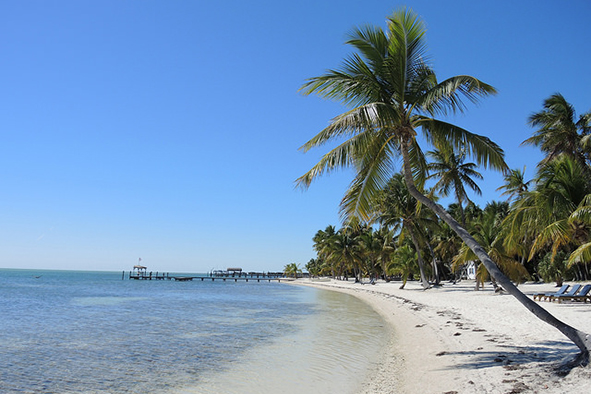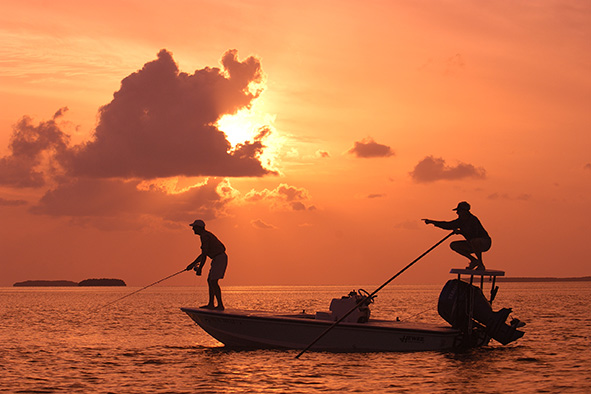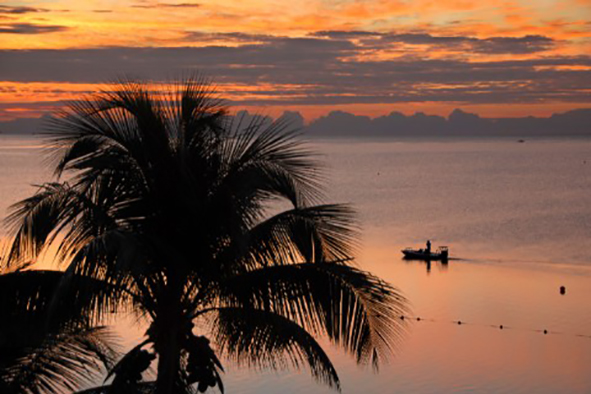For many this village is a pass-through on the road to Key West. But those who pull over will find a laid-back town full of history and island charm.

The beach at Islamorada (Photo: Pietro Valocchi via Flickr)
The sunlight bouncing off the water is blinding. I’m standing on the balcony of the hotel my fiancé Greg and I rented for the weekend. It’s really more of a marina than a hotel. Below me a charter of sunburned revelers holding beer cans and fishing poles pulls out of its boat slip.
An island chain 12 miles long, Islamorada sits almost smack dab in between Miami and Key West International Airports. They call it the Sport Fishing Capital of the World, but we’re not here to wrestle tarpons or hook sailfish. A dear friend is getting married tonight and we have just a few hours to explore.
We’re already off to a late start. Blame the fruity, island-themed cocktails at last night’s rehearsal dinner.
We make our way slowly to the car. The shells covering the parking lot crunch under our feet and a crab the size of a baseball skitters out of our way. It disappears into the scrubby pines as we pull onto the main drag.
The Place Without Hills
The first thing that strikes you about driving in the Florida Keys is the flatness. The Overseas Highway, a narrow, 98-mile strip that connects the islands, sits barely above sea level. You can almost feel the water lapping into the backyards of the businesses and homes that hug the road.
For many in the cars around us, Islamorada is just another pass-through city on the road to Key West. This village, with its art deco hotel signs, salty charter captains and skeletal lighthouses, is of little interest compared to the debauchery waiting for them in the southernmost Key. They drive on, stopping only when their gas tanks or bladders cry for attention.
We leave the stream of rental cars and battered pickup trucks to pull into Mangrove Mike’s Cafe. Another shell parking lot crunches under our flip flops.
The hostess calls us “sweety” and “honey” as Greg and I follow her through a corridor of sea foam green booths to a table in the back. Fans dangling from the low ceiling mix the smells of pancakes and homefries with sunscreen and saltwater. We watch a live feed of people hand feeding tarpons at a nearby marina as we wait for our omelets.
This Saturday morning the restaurant is crowded and by the time our plates are cleared there’s only a few hours to explore before the wedding.
Fortunately one of the highest rated Tripadvisor attractions is right next door. We follow a narrow hallway to the Lobster Trap Art Gallery, emerging in a room that looks like a Guy Harvey t-shirt exploded on the walls.
From carpet to ceiling, the walls are covered in vivid paintings of aquamarine waters, green parrots and orange sunsets. Painted egrets dive for fish, and sea turtles swim through abstract seas. All of the paintings, portraits and photos are framed in old lobster traps. The barnacle-crusted wood has been stained and dyed, weathered and stapled.
A woman appears from behind a display of manatee paintings, armed with a big grin and the store’s story. This all started as a hobby, she explains. After retiring, the owners took a painting class at a local community college. They started framing their homework assignments in old lobster traps.
Friends told them they should sell it. So they did.
She handed us a card and disappeared behind a string of painted buoys hanging from the ceiling.

A Florida Keys guide points his angler to a bonefish off Islamorada. (Photo: Bob Krist/Florida Keys News Bureau)
Bugged
Back in the car a drawbridge raises us above sea level. The water below is stripes of green and blue in between fingers of tree-covered inlets. Boats race under the bridge, their wakes a white swath behind them. The horizon is mind-blowingly flat.
A small brown sign indicates we’ve arrived at our final destination, Windley Key Fossil Reef Geological State Park. Without this park, we might not be here today.
In the early 1900s this land was dug up to build Henry Flagler’s Overseas Railroad, which connected the Keys to the rest of the state. The railroad was knocked out by a category five hurricane in 1935, but parts of the path now support the highway.
We pass a $5 bill to the park ranger to cover our admission. She gives us a map and a warning: “The mosquitos are bad today. Really bad.” She doesn’t take the money until we assure her several times we’re okay with the bugs.
But once we slip into the forest hammock we realize we were wrong. In less than a minute our bare legs are polka dotted with hungry mosquitos. They swirl in our ears as we try to read the markers lining the trail. The unlucky ones leave bloody smears against our skin as we fend them off. Less than three minutes into our visit we are running back over the coral lined path, flailing our arms and gritting our teeth against the itch.
The ranger is sympathetic. She withholds the “I told you so”; and our $5 bill.
By then the sun is low and it’s time to get ready for the wedding. At the ceremony we slip into a row near the back, scratching our mosquito bites as a white-suited waiter passes with a tray of fruity cocktails.

Sunrise over Islamorada (Photo: Andy Newman/Florida Keys News Bureau)